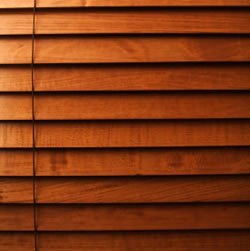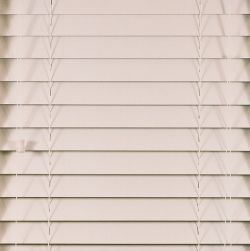Are Faux Wood Blinds Better Than Wood Blinds?
No other material can compare to the natural beauty and richness of real wood, whether you are looking at flooring, furniture or window treatments such as blinds and indoor shutters. As shown in Figure 1, no two pieces of wood are identical, each has its own grains and markings.

Figure 1 - Wood window blind
Materials used to simulate wood are always identical in appearance, grains and other markings, on the simulated wood, are manmade and created by using photographic or coloring techniques
North America window blinds and indoor shutters made of wood are still considered to have a high level of "class" and because of that are one of the most widely used window treatments.
Wood is a renewable resource and is definitely an environmentally friendly material.
However, wood is not an inexpensive product and when compared to other window treatment materials wood comes out as one of the highest costs, per square foot, of window surface covered.
Natural wood window treatments can be used in almost any room in your home. However, they should not be used in bathrooms, laundry rooms or other areas where moisture levels can be high, as wood will absorb moisture, which can lead to the deterioration of the material.
For homeowners who desire the appearance of a natural wood product for their window treatments, but, like many of us, have budget constraints, manufacturers have created faux wood blinds and shutters. The word faux is placed in front of many home improvement and remodeling products and materials. The definition of the word "faux", according to the Webster's dictionary, is; artificial, fake.
Most of the faux wood window blinds (Figure 2) and shutters are made of vinyl or a mixture of saw dust and vinyl. Manufacturers have numerous trade names for the products, but they are all manmade materials that are created to simulate natural wood products, but in the writers opinion, it is like saying that a Kia is the same as an Aston Martin, because they are both cars.

Figure 2 - Faux wood window blind
Faux wood or vinyl window treatments have two advantages over natural wood blinds or shutters:
- They are less expensive than wood,
- They are far more moisture resistant than wood.
Faux wood or vinyl window treatments have eight disadvantages over natural wood blinds or shutters:
- They do not have the richness or class of real wood,
- Color choices are limited,
- They are heavier than wood,
- Because they are heavier and manufactured they are not available in any size,
- They do not have the inherent strength and durability of wood,
- They have a tendency to yellow in direct sunlight,
- They are not environmentally friendly.
- Like size faux wood window blinds will have more ladders (the strings that connect each of the slats to one another) than wood blinds.
Another type of faux wood window blind and shutter is manufactured from an expanded foam material. Foam window treatments are made for those homeowners with real budget constraints. Foam window treatments have a number of disadvantages compared to wood and vinyl:
- They are very fragile,
- They have a tendency to sag,
- Opening and closing mechanisms are of exceedingly poor quality and have a very limited life.
- They are very heavy.
Foam window treatments are a popular item at the big box and on-line retailers as they are inexpensive, which makes them look like a real bargain. However, if you require any product longevity or a reasonable appearance, I highly suggest that you do not purchase window treatments manufactured from foam.
Another consideration when choosing wood or faux wood blinds are the strings (ladders) that connect all of the slats together and allow the mechanism to open and close the blind.
Wood, because it is stiff and rugged require less ladders than faux wood window blinds. The ladders take away from the overall appearance of the window blind. The more ladders, the harder it is to clean the slats. The ladders are laced through holes in the slats, when closed these holes allow the penetration of light and what you see, when the blind is closed is a rectangle that looks as if it was poked with a pin. The fewer number of ladders, the fewer number of pin holes!
It should also be noted that vinyl can have a static quality to it that attracts dust. Vinyl or faux wood window treatments usually require cleaning more often than wood.
